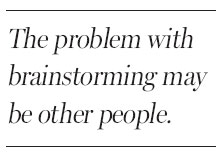Through solitude, a path to inspiration
Updated: 2012-02-05 08:01
By Anita Patil(The New York Times)
|
|||||||
When President Obama recently talked to Time magazine about his cool, aloof style and his ineffective relationship with House Speaker John A. Boehner, he said: "You know, the truth is, actually, when it comes to Congress, the issue is not personal relationships. My suspicion is that this whole critique has to do with the fact that I don't go to a lot of Washington parties. And as a consequence, the Washington press corps maybe just doesn't feel like I'm in the mix enough with them, and they figure, well, if I'm not spending time with them, I must be cold and aloof."
Or perhaps just more productive.

Research suggests that people are more creative and efficient when they enjoy some privacy. Despite all the digital chatter, open-plan offices, social networking and group learning, it just may be that solitude is the path to innovation, achievement and insight.
"Culturally, we're often so dazzled by charisma that we overlook the quiet part of the creative process," Susan Cain, the author of "Quiet: The Power of Introverts in a World That Can't Stop Talking," wrote in The Times. Ms. Cain said that it is one thing to associate with a group in which each member works on apiece of the puzzle, but it is another to be "corralled into endless meetings or conference calls conducted in offices that afford no respite from the noise and gaze of co-workers. Studies show that open-plan offices make workers hostile, insecure and distracted." The chances of suffering high blood pressure, stress, flu, exhaustion and making more mistakes increase, she says.
Yet workers consistently gather, on bouncy exercise balls or in hammocks, in communal atriums, with doughnuts or at Davos, to brainstorm. Such sessions have long been praised as the feel-good way to unleash creativity and boost productivity.
"Like it or not, human creativity has increasingly become a group process," wrote Jonah Lehrer last month in The New Yorker. But recent research by Nicholas Kohn and Steven Smith in Texas shows that brainstorming may be inefficient. The problem? Well, other people. In a group, people can tend to fixate on one idea, blocking out other possibilities, or they sit back and let others do the work. Eventually, in what the researchers call "collaborative fixation," group members start to mimic others' opinions and conform.

How can we end the groupthink? Go away, far away, and retreat into yourself. Mark Trippetti, an advertising consultant in New York, recently surrendered his laptop and iPhone to storage at a remote mountainside center in Colorado and cut off all human contact for a month, he told The Times. His primary activities were meditation and mantra recitation.
"The whole idea is for you to take a very close look at the you you have become in your mind," he told The Times.
This silent, solo retreat - known as lerung, part of a practice of Tibetan Buddhism - is in vogue. And meditation and retreat centers everywhere offer isolated getaways, often for $25 to $35 a night, for many overworked and overcommitted professionals.
Tai Pimputkar, who works at an investment bank in Connecticut, went on an eight-day solo retreat at the Karme Choling Shambhala Meditation Center in Vermont. She told The Times: "You learn what's healthy for you and what you want to accept into your life and learn what you want to leave behind."
And perhaps that's everyone else.
For comments, write to nytweekly@nytimes.com
(China Daily 02/05/2012 page9)